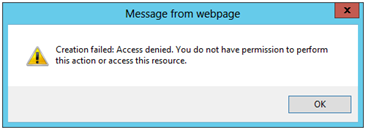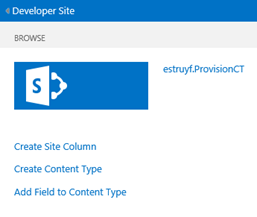Now that sandbox solutions with code behind are deprecated in SharePoint 2013, we need to find new ways to provision content types and site columns to a site. One way to do it is to provision them via a PowerShell script, which is not a bad idea. Another way could be to provision them via a SharePoint app.
If you have the choice between the two, I would go for the PowerShell approach, because it is easier to manage the scripts. When you don’t have the choice, and need to use an app for this, you can us this blog post as a reference.
In this post I’ll show you how you could provision a site column, content type, and link the site column to the content type.
Creating a Provisioning App
The first thing to do is creating a new App for SharePoint 2013 project (I set the host option of the app to SharePoint-hosted).
When you’ve created your project, set the Permission
requests settings in the AppManifest.xml file to Web - Manage.
If you don’t set this permissions or set the permission to a lower level (read or write), you will eventually end up with the following message when your code gets executed:
App Page Content
The HTML markup for the PlaceHolderMain section of the Default.aspx page, looks like this:
1
2
3
4
5
6
7
| <div>
<p><a href="#" id="CreateSiteColumn">Create Site Column</a></p>
<p><a href="#" id="CreateContentType">Create Content Type</a></p>
<p><a href="#" id="LinkFieldToContentType">Add Field to Content Type</a></p>
<p id="message"></p>
</div>
|
As you can see, three links will be shown, this way it is easier to test each step separately. You can also combine them if you want.
App Provisioning Code
The coding will be done in the App.js file. The default App.js content may be deleted.
Important: you need to get the context of the SharePoint site for which you want to provision the content types. This will not be the current context, because that is the app site context. To get the context of the site collection, you can use this piece of code:
1
2
| clientContext = new SP.ClientContext("/");
web = clientContext.get_web();
|
I already told you that I split up everything in separately steps. For that I created three functions:
- CreateSiteColumns;
- CreateContentType;
- LinkFieldToContentType.
The CreateSiteColumns function looks like this:
1
2
3
4
5
6
7
8
9
10
11
| // Create Site Column
function CreateSiteColumns() {
SiteColumnsCollection = web.get_fields();
var xmlField = '<Field Type="Text" DisplayName="EStruyf Field" Name="estruyf" Group="EStruyf Columns" Hidden="False"></Field>';
this.SiteColumnsCollection.addFieldAsXml(xmlField, false, SP.AddFieldOptions.AddToNoContentType);
clientContext.load(SiteColumnsCollection);
clientContext.executeQueryAsync(onCreationSuccess, onCreationFail);
}
|
The CreateContentType function looks like this:
1
2
3
4
5
6
7
8
9
10
11
12
13
| // Create Site Content Type
function CreateContentType() {
ContentTypeCollection = web.get_contentTypes();
var newContentType = new SP.ContentTypeCreationInformation();
newContentType.set_name("EStruyf Content Type");
newContentType.set_description("This is my custom EStruyf content type");
newContentType.set_group("EStruyf");
ContentTypeCollection.add(newContentType);
clientContext.load(ContentTypeCollection);
clientContext.executeQueryAsync(onCreationSuccess, onCreationFail);
}
|
The LinkFieldToContentType function looks like this:
1
2
3
4
5
6
7
8
9
10
11
12
13
14
15
16
17
18
19
20
21
22
23
24
25
26
27
28
29
30
31
32
33
34
35
| function LinkFieldToContentType() {
// Retrieve all content types
ContentTypeCollection = web.get_contentTypes();
// Retrieve the previously created field
field = web.get_fields().getByTitle("EStruyf Field");
clientContext.load(ContentTypeCollection);
clientContext.load(field);
clientContext.executeQueryAsync(onQuerySuccess, onCreationFail);
}
function onQuerySuccess() {
var contentTypeEnumerator = ContentTypeCollection.getEnumerator();
var myCt;
// Find the previously created content type
while (contentTypeEnumerator.moveNext()) {
var ct = contentTypeEnumerator.get_current();
if (ct.get_name() === "EStruyf Content Type") {
myCt = ct;
break;
}
}
if (myCt != null) {
// Create a field link reference
var fieldLink = new SP.FieldLinkCreationInformation();
fieldLink.set_field(field);
// Add the field link reference to the content type
myCt.get_fieldLinks().add(fieldLink);
myCt.update(true);
clientContext.load(myCt);
clientContext.executeQueryAsync(onCreationSuccess, onCreationFail);
}
}
|
The only thing that rests is to set some event handlers for the links on the Default.aspx page. I have done this with the following piece of code:
1
2
3
4
5
6
7
8
9
10
11
12
13
14
15
16
17
18
19
20
21
22
| $(document).ready(function () {
clientContext = new SP.ClientContext("/");
web = clientContext.get_web();
$("#CreateSiteColumn").click(function () {
$('#message').empty();
CreateSiteColumns();
return false;
});
$("#CreateContentType").click(function () {
$('#message').empty();
CreateContentType();
return false;
});
$("#LinkFieldToContentType").click(function () {
$('#message').empty();
LinkFieldToContentType();
return false;
});
});
|
Here you can download the whole script here: App.js
Executing the Code
When you installed the app on your SharePoint site, you should have the following app page:
Clicking the links, should give the following results:
Site Column
Site Content Type
Linked Field in Content Type





